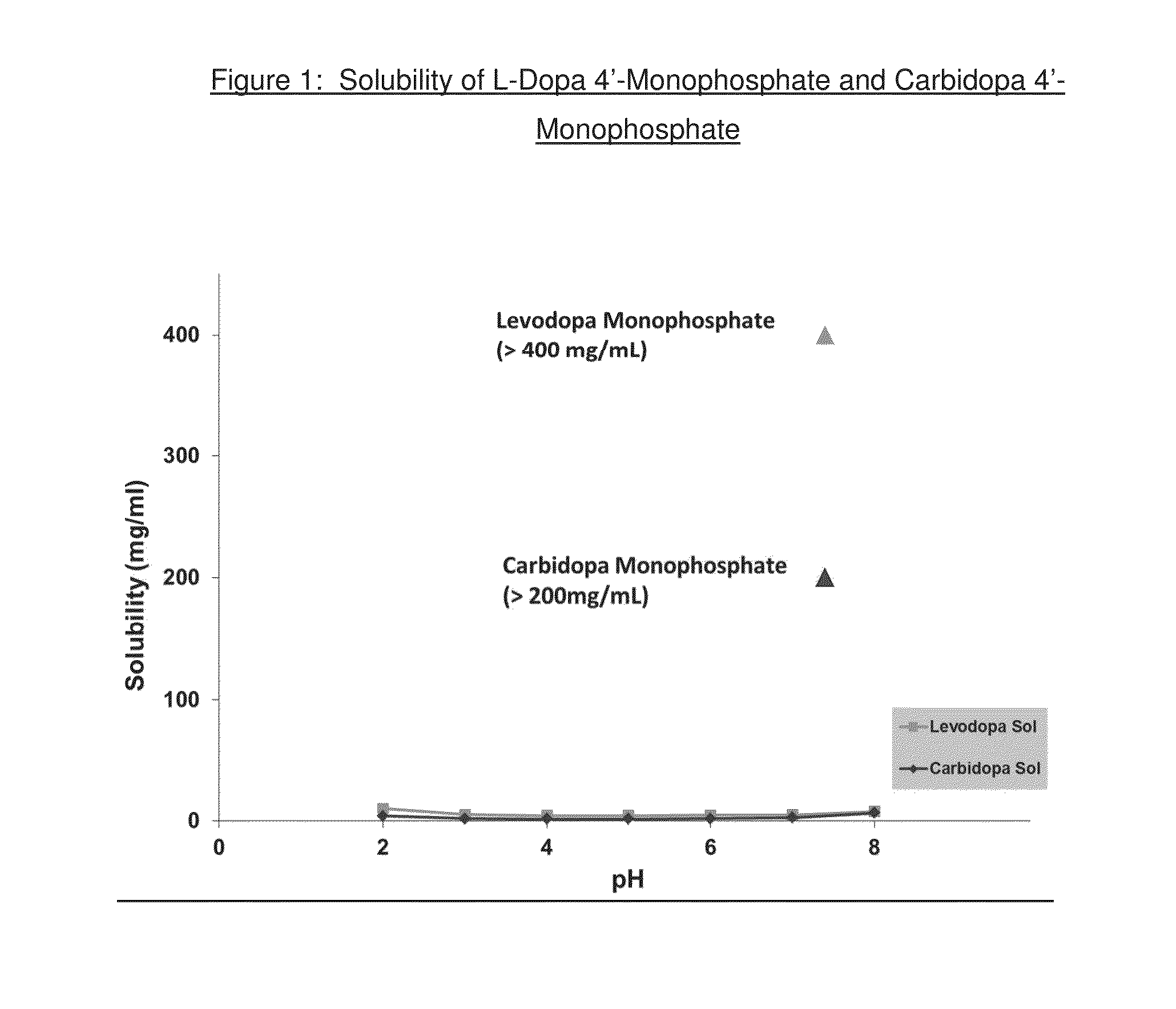Carbidopa and L-Dopa Prodrugs and Methods of Use
- Summary
- Abstract
- Description
- Claims
- Application Information
AI Technical Summary
Benefits of technology
Problems solved by technology
Method used
Image
Examples
example 1
Synthesis of L-Dopa Monophosphates
[0424]L-dopa 3′-monophosphate and L-dopa 4′-monophosphate were prepared as shown in Scheme 1 below:
[0425]Specifically, L-dopa 3′-monophosphate and L-dopa 4′-monophosphate were prepared as described in Steps 1 through 5B below.
[0426]Step 1
[0427]A solution of sodium hydroxide (40 g, 1.0 mol) in water (300 mL) was added drop-wise to a suspension of Compound 1 (100 g, 0.5 mol) in water (300 mL) over a period of 20 minutes at 0° C. Benzylchloroformate (103.9 g, 0.6 mol) in dioxane (400 mL) was added drop-wise to the suspension over a period of 30 minutes at 0° C. and then the reaction mass was stirred at room temperature for 16 hours. Reaction completion was monitored by TLC. After the complete consumption of starting material, the reaction mass was basified to pH=10 using 10% sodium hydroxide (200 mL) and extracted with MTBE (500 mL). The organic layer was separated and discarded. The aqueous layer was acidified to pH=2 using 6 N HCl (150 mL) and extrac...
example 2
Synthesis of L-Dopa Diphosphate
[0441]L-dopa 3′,4′-diphosphate was prepared as shown in Scheme 2 below:
[0442]Specifically, L-dopa 3′,4′-diphosphate was prepared as described in Steps 6 and 7 below.
[0443]Step 6
[0444]Cesium carbonate (484 g, 1.48 mol) was added in two lots to a solution of Compound 3 (250 g, 0.59 mol) in dimethylformamide (2.5 L) at 0° C. A 10% w / w solution of dibenzylphosphoryl chloride in toluene (3.52 Kg, 1.18 mol) was added drop-wise to this mixture over a period of one hour at 0° C. and then the reaction mass was stirred at room temperature for 2 hours. Reaction completion was monitored by TLC. After the complete consumption of the starting material, the reaction mass was cooled to 0° C. to 5° C. and quenched with water (5 L). The organic layer was separated and the aqueous layer was extracted with toluene (1 L). The combined organic layer was washed with water (1 L), saturated sodium chloride solution (0.5 L), dried over sodium sulfate, filtered, and concentrated...
example 3
Synthesis of Carbidopa Monophosphates
[0447]Carbidopa 3′-phosphate and carbidopa 4′-phosphate were prepared as shown in Scheme 3 below:
[0448]Specifically, carbidopa 3′-phosphate and carbidopa 4′-phosphate were prepared as described in Step 1 below.
[0449]Step 1
[0450]A thick mixture of phosphorus pentoxide (2.325 g, 16.38 mmol) and phosphoric acid (85% aq., 1.79 mL, 26.2 mmol) was heated to 100° C. for 15 minutes resulting in a clear solution. The solution was cooled back to 50° C. and carbidopa monohydrate (0.400 g, 1.64 mmol) was added. After 3 hours, the solution was cooled to room temperature, stirred for 14 hours, and then warmed to 35° C. After 24 hours, the solution was cooled to room temperature and stirred for 60 hours. Water (2 mL, exotherm to 50° C.) was added, the solution was stirred for 5 minutes, and then analyzed by HPLC (Agilent Poroshell 120 EC-C18 #693975-902 4.6×150 mm column, 1 mL / minute 0.1% aq. H3PO4 / CH3CN, 3 minute 97:3, 4 minute gradient to 70:30, 2 minute grad...
PUM
| Property | Measurement | Unit |
|---|---|---|
| Time | aaaaa | aaaaa |
| Solubility (mass) | aaaaa | aaaaa |
| Solubility (mass) | aaaaa | aaaaa |
Abstract
Description
Claims
Application Information
 Login to View More
Login to View More - R&D
- Intellectual Property
- Life Sciences
- Materials
- Tech Scout
- Unparalleled Data Quality
- Higher Quality Content
- 60% Fewer Hallucinations
Browse by: Latest US Patents, China's latest patents, Technical Efficacy Thesaurus, Application Domain, Technology Topic, Popular Technical Reports.
© 2025 PatSnap. All rights reserved.Legal|Privacy policy|Modern Slavery Act Transparency Statement|Sitemap|About US| Contact US: help@patsnap.com



